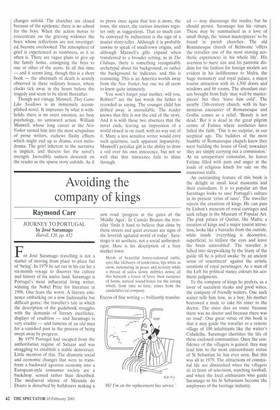Avoiding the company of kings
Raymond Carr
JOURNEY TO PORTUGAL by Jose Saramago
Harvill, £20, pp. 452
For Jose Saramago travelling is not a matter of moving from place to place but of 'being'. In 1979 he set out in his car for a six-month voyage to discover the culture and history of his native land. Saramago is Portugal's most influential living writer, winning the Nobel Prize for literature in 1998. One fears the worst. A literary eminence embarking on a now fashionable but difficult genre: the traveller's tale in which the description of the guidebook struggles with the demands of literary excellence, displays of erudition — and Saramago is very erudite — and laments of an old man ,for a vanished past in the process of being swept away by progress.
By 1979 Portugal had escaped from the authoritarian regime of Salazar and was struggling to establish a stable democracy. Little mention of this. The dramatic social and economic changes that were to transform a backward agrarian economy into a European-style consumer society are a backdrop, sensed rather than described. The mediaeval silence of Miranda do Douro is disturbed by bulldozers making a new road 'progress at the gates of the Middle Ages'. In Castelo Branco the traveller 'finds it hard to believe that close by these streets and quiet avenues are signs of the feverish agitated world of today'. Saramago is an aesthete, not a social anthropologist. Here is his description of a busy market town:
Herds of beautiful honey-coloured cattle, eyes like lifebuoys of tenderness, lips white as snow, ruminating in peace and serenity while a thread of saliva slowly dribbles down, all this beneath a forest of lyres, their carapace of horns, natural sound-boxes for the lowing which, from time to time, arises from the candelabra'ed company.
Excess of fine writing — brilliantly translat ed — may discourage the reader, but he should persist. Saramago has his virtues. These may be summarised as a love of small things, the 'minor masterpieces' to be found in parish churches. The old Romanesque church of Belmonte 'offers the traveller one of the most moving aesthetic experiences in his whole life'. His aversion to mere size and his patriotic disdain for the fashion for foreign models are evident in his indifference to Mafra, the huge monastery and royal palace, a major tourist attraction with its 4,500 doors and windows and 86 rooms. The abundant statues brought from Italy 'may well be masterpieces' but they 'leave him cold'. The nearby 13th-century church, with its harmonious encounter of Romanesque and Gothic comes as a relief. 'Beauty is not dead.' But it is dead in the great pilgrim centre of Fatima where aesthetics have failed the faith. 'This is no surprise, in our sceptical age. The builders of the most humble of Romanesque chapels knew they were building the house of God; nowadays they are simply carrying out a commission.' As an unrepentant rationalist, he leaves Fatima filled with pain and anger at the loads of religious kitsch for sale on the numerous stalls.
An outstanding feature of this book is the delight in small local museums and their custodians. It is to popular art that Saramago looks to save Portugal's culture in its present 'crisis of taste'. The traveller rejects the creations of kings. He can pass by Lisbon's museum of royal carriages and seek refuge in the Museum of Popular Art. The pink palace of Queluz, like Mafra, a creation of kings and a major tourist attraction, looks like a barracks from the outside, while inside 'everything is decorative, superficial, to titillate the eyes and leave the brain untroubled'. The traveller is lulled into sleepwalking by the litany of the guide till he is jolted awake 'by an ancient sense of resentment' against the artistic creations of royal personages. As a man of the Left his political stance colours his aesthetic judgments.
To the company of kings he prefers, as a lover of succulent steaks and good wines, the company of friendly waiters. One such waiter tells him how, as a boy, his mother borrowed a mule to take his sister to the doctor. The sister dies en route 'because there was no doctor and because there was no road'. One great virtue of this book is that it may guide the traveller to a remote village of 100 inhabitants like the waiter's Cidadelhe. Saramago cherishes the life of these enclosed communities. Once the confidence of the villagers is gained, they may lead him to the most extraordinary statue of St Sebastian he has ever seen. But this was all in 1979. The attractions of communal life are diminished when the villagers Sit in front of television, watching football, and when the local enthusiasts who guide Saramago to his St Sebastians become the employees of the heritage industry.


































































 Previous page
Previous page